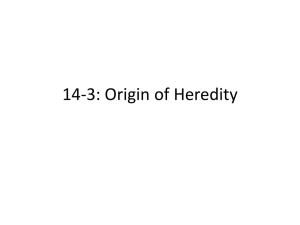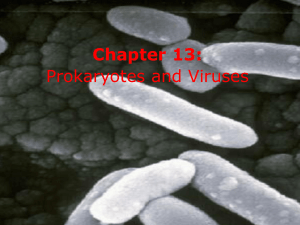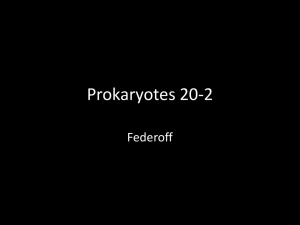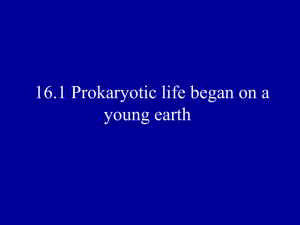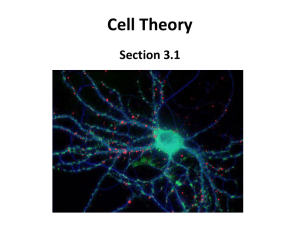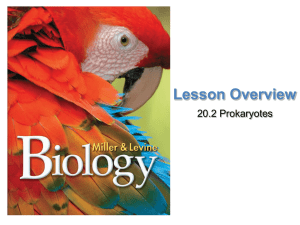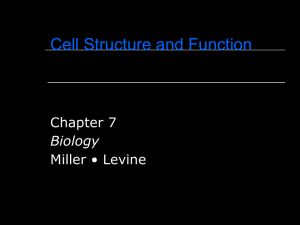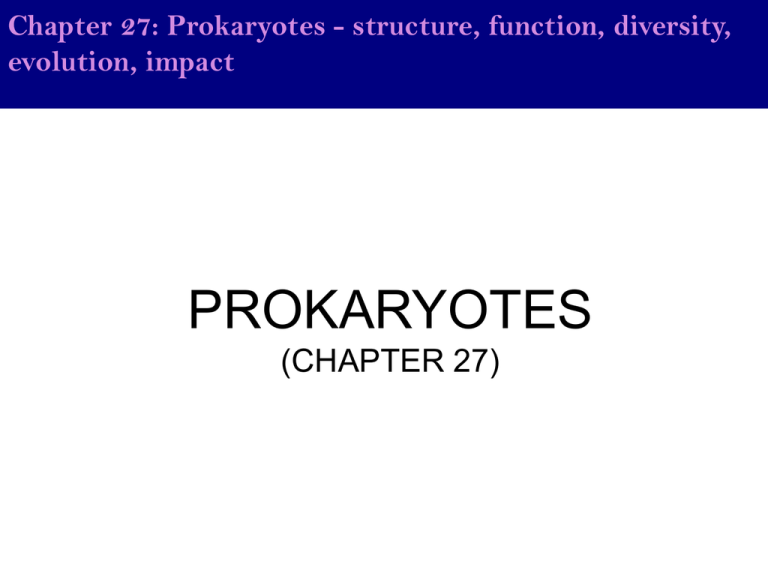
Chapter 27: Prokaryotes - structure, function, diversity,
evolution, impact
PROKARYOTES
(CHAPTER 27)
Chapter 27: Prokaryotes - structure, function,
diversity, evolution, impact
Structure of Prokaryotes
Chapter 27: Prokaryotes - structure, function,
diversity, evolution, impact
Structure of Prokaryotes
Bacteria come in two flavors:
Gram positive vs Gram-negative prokaryotes
Why are they called “gram-positive” and “Gram-negative”?
Chapter 27: Prokaryotes - structure, function,
diversity, evolution, impact
Structure of Prokaryotes
Gram Staining
A simple procedure used to stain bacteria:
The thick peptidoglycan cell wall of gram-positive bacteria prevents the stain (crystal
violet-iodine) from leaving the cell when decolorization is carried out.
Chapter 27: Prokaryotes - structure, function,
diversity, evolution, impact
Structure of Prokaryotes
Taking advantage of the peptidoglycan cell wall:
Penicillin
Antibiotic that inhibits enzyme DD-transpeptidase,
which is involved in building and rearranging the
cell wall.
DD-transpeptidase with penicillin bound:
penicillin
Chapter 27: Prokaryotes - structure, function,
diversity, evolution, impact
Structure of Prokaryotes
Capsules
Capsules surround cell walls
of many prokaryotes.
Structure:
- Composed of polysaccharide or
protein
Function:
- Allows bacteria to bind to other
bacteria or to another substrate
like your cells.
- Protection from immune system
Chapter 27: Prokaryotes - structure, function,
diversity, evolution, impact
Structure of Prokaryotes
Fimbriae and Pili
Function:
- Allows bacteria to bind to other
bacteria or to another substrate
like your cells.
- Sex pili are specialized pili used
during conjugation.
Chapter 27: Prokaryotes - structure, function,
diversity, evolution, impact
Motility of Prokaryotes
Flagella
- 50% of prokaryotes capable of
directional movement.
- Flagella are most common, but not
the only means of motility
- NOT covered by plasma membrane
like in eukaryotes.
- Basal apparatus (motor proteins)
cause flagella to ROTATE, not whip
like in eukaryotes.
The very different structures of
the prokaryotic and eukaryotic
flagella is a clear example of…
Is this bacterium gram + or gram -?
Chapter 27: Prokaryotes - structure, function,
diversity, evolution, impact
Motility of Prokaryotes
Taxis
Taxis = to move towards or away from
a stimulus
Chemotaxis – towards (positive) or
away (negative) from a chemical.
Phototaxis – towards (positive) or
away (negative) from light.
Bacterium exhibiting positive chemotaxis
Chapter 27: Prokaryotes - structure, function,
diversity, evolution, impact
Internal and Genomic Organization - membranes
Membrane organization reminiscent
of mitochondria and chloroplasts
Chapter 27: Prokaryotes - structure, function,
diversity, evolution, impact
Internal and Genomic Organization - membranes
Single circular chromosome in nucleoid region plus plasmids
Chapter 27: Prokaryotes - structure, function,
diversity, evolution, impact
Reproduction and Adaptation in Prokaryotes
- Binary fission (asexual) every 1 to 3 hours (some only 20 min)
- ENDOSPORES
- Formed by certain bacteria when environment goes south
(lacking a nutrient, etc…)
- Highly Resistant cells
- Bacterium replicates
chromosome and surrounds
with tough wall.
- Remainder of cell breaks
down
- Most endospores survive
boiling and can persist
dormant for 100’s of years
Chapter 27: Prokaryotes - structure, function,
diversity, evolution, impact
Prokaryotic Nutritional Classes
- There are prokaryotes in every nutritional class:
Chapter 27: Prokaryotes - structure, function,
diversity, evolution, impact
Prokaryotic Metabolic Relationships to O2
Obligate (strict) aerobes
- Use oxygen for cell resp. CANNOT be without it
Facultative aerobes
- Use O2 if present, switch to fermentation in absence of O2
Obligate (strict) anaerobes
- Poisoned by O2
- Two types:
1. Fermentation – bacteria that only do fermentation
2. Anaerobic respiration – use substance other than O2 as final
electron acceptor like nitrate (NO3-) and sulfate (SO42-)
Chapter 27: Prokaryotes - structure, function,
diversity, evolution, impact
Nitrogen Metabolic
Nitrogen Fixation
N2 NH4+
Nitrogen fixing bacteria take
atmospheric nitrogen (N2) and can
convert it to NH4 (ammonium) for use
in its amino acids and nitrogenous
bases. Excess is secreted and used by
plants as shown to the right…
THIS IS THE ONLY WAY NITROGEN
CAN ENTER THE ECOSYSTEM…THIS
IS WHERE ALL YOUR NITROGEN
COMES FROM!!
Chapter 27: Prokaryotes - structure, function,
diversity, evolution, impact
Prokaryotic Metabolic Cooperation
Colonial Cooperation: Certain bacteria like the cyanobacterium Anabaena in colonies.
Photosynthetic cells are mixed with heterocyst cells, which fix nitrogen only since O2 produced
during photosyn. inhibits nitrogen-fixing enzymes.
Chapter 27: Prokaryotes - structure, function,
diversity, evolution, impact
Prokaryotic Metabolic Cooperation
Biofilms: Surface coatings of cooperating bacteria. Above, dental plaque, a biofilm that forms on tooth surfaces.
Channels form in the biofilm to allow nutrients and waste to enter and exit the interior of the film respectively.
Chapter 27: Prokaryotes - structure, function,
diversity, evolution, impact
Prokaryotic Phylogeny
Chapter 27: Prokaryotes - structure, function,
diversity, evolution, impact
Comparing the three domains:
Chapter 27: Prokaryotes - structure, function,
diversity, evolution, impact
Archaea Bacteria
Chapter 27: Prokaryotes - structure, function,
diversity, evolution, impact
Archaea Bacteria
Extremophiles - “lovers” of extreme conditions
1. Extreme Thermophiles
- thrive in hot environments
Ex. Sulfolobus – genus that live in sulfur-rich
volcanic springs pushing 90°C.
2. Extreme Halophiles
- thrive in high salt environments
3. Methanogens
- Obligate (strict) anaerobes – poisoned by O2
- Many species live in swamps and marshes
- Use CO2 to oxidize H2, releasing CH4 (methane) as waste.
Chapter 27: Prokaryotes - structure, function,
diversity, evolution, impact
Eubacteria
Chapter 27: Prokaryotes - structure, function,
diversity, evolution, impact
Eubacteria
Fig 27.13 in book
Chapter 27: Prokaryotes - structure, function,
diversity, evolution, impact
Prokaryotic Symbiotic Relationships
Symbiosis
– relationship b/w organisms of different species
in direct contact
Hst – larger organism
Symbiont – smaller organism
Three Forms:
Mutualism (+/+)
Human Intestinal bacteria
Commensalism (+/0)
Parasitism (+/-)
Glowing below eye of flashlight fish is organ containing
bioluminescent bacteria. Light used to attract predators and
mates. Bacteria gets nutrients from fish.
Chapter 27: Prokaryotes - structure, function,
diversity, evolution, impact
Pathogenic (parasitic) Prokaryotes
- Cause about half of all human diseases
**2 to 3 million die a year from lung disease caused by Mycobacterium tuberculosis
**2 million others die of diarrheal disease caused by prokaryotes
Lyme disease
- Most widespread pest-carried disease in United States
- Tick carries spirochete Borrelia
burgodorfi
- The tick is called a vector
because it transmits the disease as
would a mosquito that transmits the
protist that causes malaria.
Chapter 27: Prokaryotes - structure, function,
diversity, evolution, impact
Pathogenic (parasitic) Prokaryotes
- Cause about half of all human diseases
**2 to 3 million die a year from lung disease caused by Mycobacterium tuberculosis
**2 million others die of diarrheal disease caused by prokaryotes
Lyme disease
- Most widespread pest-carried disease in United States
- Tick carries spirochete Borrelia
burgodorfi
- The tick is called a vector
because it transmits the disease as
would a mosquito that transmits the
protist that causes malaria.
Chapter 27: Prokaryotes - structure, function,
diversity, evolution, impact
Pathogenic Prokaryotes
Exotoxins
Toxic proteins secreted by pathogenic bacteria
Ex. Cholera
- Caused by Vibrio cholera
- Life threatening diarrhea
Exotoxin called cholera toxin (CTX) causes intestinal cells to secrete Cl- into gut
and water follows by osmosis
Chapter 27: Prokaryotes - structure, function,
diversity, evolution, impact
Pathogenic Prokaryotes
Endotoxins
-Toxic lipopolysaccharides (glycosylated
phosopholipids) found in outer membrane of
Gram negative bacteria.
- Released when cell dies and outer
membrane breaks down
Ex. All members of genus Salmonella
- Typhoid fever (fecal oral route)
- Food poisoning (esp chicken)
Typhoid bacillus
(Salmonella enterica)
Chapter 27: Prokaryotes - structure, function,
diversity, evolution, impact
Prokaryotes in Research, Technology and Society
- Convert milk to cheese / yogurt
- E. coli in gene cloning
- Agrobacterium tumefaciens to make transgenic plants
- Bioremediation
Use of organisms to remove pollutants from the environment
Chapter 27: Prokaryotes - structure, function,
diversity, evolution, impact
Protists (Chapter 28)
1. More structural and functional diversity than any other
group of organisms…
2. Most are unicellular, some colonial and multicellular…
3. Most nutritionally diverse eukaryotes
A. photoautotrophs
B. heterotrophs
C. mixotrophs – combine photosyn with hetertrophic
nutrition
Chapter 27: Prokaryotes - structure, function,
diversity, evolution, impact
Protists
Broken into three general categories based on ecological context:
1. Photosynthetic (plant-like) protists
- algae
2. Ingestive (animal-like) protists
- protozoans
3. Absorptive (fungus-like) protists
Chapter 27: Prokaryotes - structure, function,
diversity, evolution, impact
Protists
How did such incredible diversity arise?
Many species resulted from two rounds of endosymbiosis…
Chapter 27: Prokaryotes - structure, function,
diversity, evolution, impact
Phylogeny of protists
Fig. 28.4
Phylogenetic tree showing the major clades of protists.
Chapter 27: Prokaryotes - structure, function,
diversity, evolution, impact
Phylogeny of protists
Fig. 28.4
What’s a clade?
A complete branch of a phylogenetic tree. Above how many clades are highlighted?
Two, the blue and the red because these are complete branches. The green is not
complete.
Chapter 27: Prokaryotes - structure, function,
diversity, evolution, impact
Phylogeny of protists
Let’s examine a handful of these clades…
Fig. 28.4
Chapter 27: Prokaryotes - structure, function,
diversity, evolution, impact
Kingdom Euglenozoa
Characterized by spiral or
crystalline rod within flagella in
addition to 9+2 arrangement of
microtubules.
Cyrstalline structure has unknown
function.
Fig. 28.8
Chapter 27: Prokaryotes - structure, function,
diversity, evolution, impact
Kingdom Euglenozoa
Fig. 28.8
Phylum kinetoplastid
Ex. Genus Trypanosoma
- Causes sleeping sickness
- Spread by African tsetse fly
- Fatal if untreated
- Evade immune system by repeatedly changing the proteins on the surface of the cell
Chapter 27: Prokaryotes - structure, function,
diversity, evolution, impact
Kingdom Euglenozoa
Phylum euglenid
Ex. Euglena
- Found in freshwater
- Photoautotroph if sunlight available otherwise heterotroph by absorbing
nutrients from environment (mixotroph)
Fig. 28.8
Chapter 27: Prokaryotes - structure, function,
diversity, evolution, impact
Phylogeny of protists
Let’s examine a handful of these clades…
Fig. 28.4
Chapter 27: Prokaryotes - structure, function,
diversity, evolution, impact
Kingdom Alveolata
Characterized by sacs below
membrane called alveoli having
yet unknown function
Fig. 28.8
Chapter 27: Prokaryotes - structure, function,
diversity, evolution, impact
Kingdom Alveolata
Phylum dinoflagellates
- Abundant as both marine and freshwater phytoplankton
Phytoplankton – phyto = photosynthetic, plankton = “free-drifting”
- free-drifting photosynthetic organisms (cyanobacteria is also a
large part of phytoplankton)
- Bloom (explosion of growth) can cause “red tide”
- Secrete toxins that bioaccumulate in molluscs making them dangerous to eat
- Have internal “plates” of cellulose giving its characteristic shape…
Chapter 27: Prokaryotes - structure, function,
diversity, evolution, impact
Kingdom Alveolata
Phylum Ciliates
- Obviously use cilia to move and feed
Ex) Paramecium
Two types of nuclei
- Large (macro) nucleus
- Smaller (micro) nucleus
- Can have more than one of each
Chapter 27: Prokaryotes - structure, function,
diversity, evolution, impact
Kingdom Alveolata
Phylum Ciliates
Macronucleus
- Contains dozens of copies of genome
- Genes are not on chromosomes (they don’t have chromosome)
- Arranged in small units each having many duplicates of a single gene
- The gene products (i.e. proteins) control daily functions like feeding,
waste removal, etc…
Chapter 27: Prokaryotes - structure, function,
diversity, evolution, impact
Kingdom Alveolata
Phylum Ciliates
Feeding
- Mainly on bacteria, which are moved through oral groove and
phagocytosed at “cell mouth” into food vacuoles.
- Food vacuoles fuse with lysosomes
- Undigestable material is egested when lysosomes fuse with cell
membrane
Chapter 27: Prokaryotes - structure, function,
diversity, evolution, impact
Kingdom Alveolata
Phylum Ciliates
Reproduction
- Mostly asexually by “binary fission”
Conjugation
- Genetic diversity, NOT REPRODUCTION
- two organisms exchange haploid micronuclei (see fig 28.12b above and
use book for more detail)
Chapter 27: Prokaryotes - structure, function,
diversity, evolution, impact
Phylogeny of protists
Let’s examine a handful of these clades…
Fig. 28.4
Chapter 27: Prokaryotes - structure, function,
diversity, evolution, impact
Kingdom Stramenopila
Phylum Diatom (Bacillariophytes)
- Unicellular Algae
- glass-like silica based cell wall as shown in figure
- Protection from predators
- Withstand pressures up to 1.4 million kg/m2 (pressure applied by the
leg of a table with an elephant standing upon it)
Chapter 27: Prokaryotes - structure, function,
diversity, evolution, impact
Kingdom Stramenopila
Phylum Diatom (Bacillariophytes)
Reproduction
- Usually asexually by mitosis
- Sexual reproduction is not common, but does occur
Diversity
- Estimated 100,000 species
- Major component of phytoplankton in oceans and lakes
Chapter 27: Prokaryotes - structure, function,
diversity, evolution, impact
Kingdom Stramenopila
Phylum Golden Algae (chrysophytes)
(chrysos = golden)
Dinobryon
- Contain yellow/brown cartenoid pigments
- Freshwater and marine plankton
- All obviously photosynthetic, some species mixotrophs
- Most unicellular, but some, as shown, are colonial
Chapter 27: Prokaryotes - structure, function,
diversity, evolution, impact
Kingdom Stramenopila
Phylum Brown Algae (phaeophytes –
guess what phaeo means…)
Kelp
- Largest and most complex algae (its what you call seaweed)
- All are multicellular and most are marine (salt water – ocean)
- Common along temperate costs like ours
Chapter 27: Prokaryotes - structure, function,
diversity, evolution, impact
Kingdom Stramenopila
Phylum Brown Algae
Sea palm (Postelsia)
Thallus
Kelp
- The body of the seaweed that is plant-like
- Basically, the holdfast, stipe (stem-like) and blades (leaf-like) (see above)
Holdfast
- root-like structure at base solely for anchoring, not absorption like roots
of plants
Chapter 27: Prokaryotes - structure, function,
diversity, evolution, impact
Kingdom Stramenopila
Phylum Brown Algae
Life-cycle: Alternation of Generations
This is important to understand
because as you might guess, since
plants evolved from multicellular
algae, they also do this.
Heteromorphic
- The two generations are
structurally different as opposed
to being isomorphic
Laminaria (a brown algae)
Chapter 27: Prokaryotes - structure, function,
diversity, evolution, impact
Phylogeny of protists
Let’s examine a handful of these clades…
Fig. 28.4
Chapter 27: Prokaryotes - structure, function,
diversity, evolution, impact
Kingdom Cercozoans and Radiolarians
- Amoeba with threadlike pseudopods
- Amoeba is a general term for a protist that uses pseudopodia to move and
feed. There is no one clade or kingdom that consists of amoebas
Chapter 27: Prokaryotes - structure, function,
diversity, evolution, impact
Kingdom Cercozoans and Radiolarians
Foraminiferans (Forams)
Radiolarian
- Foramen means “little hole”
- Tests made of silica
- Named for porous shells called tests
- Pseudopodia called axopodia
- Organic molecules hardened with CaCO3
- Pseudopodia extend through pores of shell and
fx in test formation, swimming and feeding
Both of these phyla consist of
amoebas because…
Chapter 27: Prokaryotes - structure, function,
diversity, evolution, impact
Phylogeny of protists
Let’s examine a handful of these clades…
Fig. 28.4
Chapter 27: Prokaryotes - structure, function,
diversity, evolution, impact
Kingdom Amoebozoans
- Amoeba with lobe shaped rather than threadlike pseudopods belong to this clade:
Now this amoeba belongs to the above kingdom…
Chapter 27: Prokaryotes - structure, function,
diversity, evolution, impact
Kingdom Amoebozoans
Phyla: Gymnamoeba
Phagocytosis of a ciliate:
Chapter 27: Prokaryotes - structure, function,
diversity, evolution, impact
Kingdom Amoebozoans
Phyla: Slime Molds (mycetozoans)
Were once thought to be fungus hence the name, but molecular evidence
has revealed convergent evolution
Two major types:
1. Plasmodial Slime Molds
2. Cellular Slime Molds
They in part by their life cycles…
Chapter 27: Prokaryotes - structure, function,
diversity, evolution, impact
Kingdom Amoebozoans
Phyla: Slime Molds (mycetozoans)
Plasmodial Slime Mold Life Cycle
Chapter 27: Prokaryotes - structure, function,
diversity, evolution, impact
Kingdom Amoebozoans
Phyla: Slime Molds (mycetozoans)
Cellular Slime Mold Life Cycle
Chapter 27: Prokaryotes - structure, function,
diversity, evolution, impact
Phylogeny of protists
Let’s examine a handful of these clades…
Fig. 28.4
Chapter 27: Prokaryotes - structure, function,
diversity, evolution, impact
Kingdom Rhodophyta
Rhodo = red
Red Algae
Red due to pigment known as phycoerythrin, which masks chlorophyll
Most large and multicellular, living in tropical waters
Alternation of Generations
Chapter 27: Prokaryotes - structure, function,
diversity, evolution, impact
Kingdom Chlorophyta
Chloro = green
Green Algae
Much like plants, systematics has shown close relationship b/w green algae and
plants as you would expect…
Two groups - Chlorophytes and Charophyceans
1. Chlorophytes
- More than 7,000 species, most in fresh water
- Simplest are unicellular
- These are the ones that live in mutualism
with fungus to form lichen
Watermelon snow showing the
incredible diversity of chlorophytes
*Charophyceans and most related to land plants and are discussed at beginning of Ch. 29 with plants
Chapter 27: Prokaryotes - structure, function,
diversity, evolution, impact
Kingdom Chlorophyta
Chloro = green
Green Algae
Larger size and complexity arose via:
1. Colony formation (ex. Volvox)
and multicellular filament
formation.
2. Repeated division of nuclei
without cytoplasmic division
(ex. Caulerpa)
3. True multicellular forms with
cell division and differentiation
(Ex. Ulva)
Chapter 27: Prokaryotes - structure, function,
diversity, evolution, impact
Kingdom Chlorophyta
Chloro = green
Syngamy = fusion of gametes, aka
fertilization/conception
Green Algae
Complicated life cycle of asexual and sexual stages:
Chapter 27: Prokaryotes - structure, function,
diversity, evolution, impact

